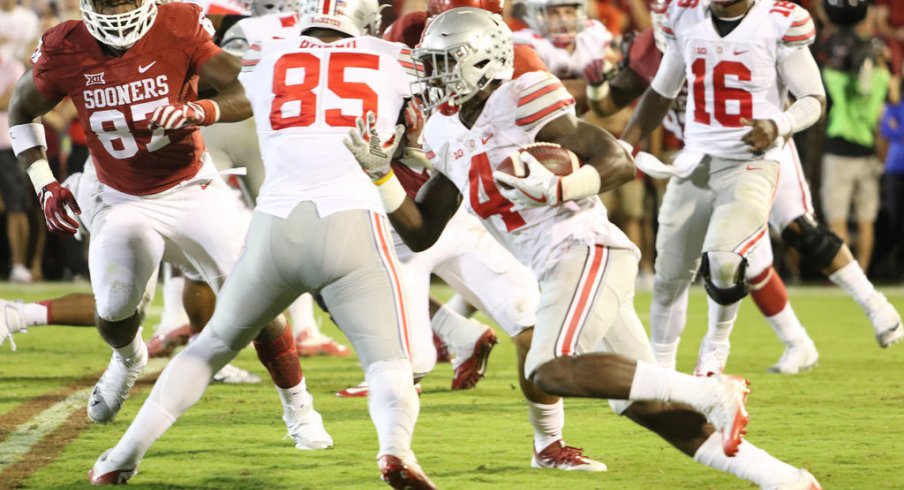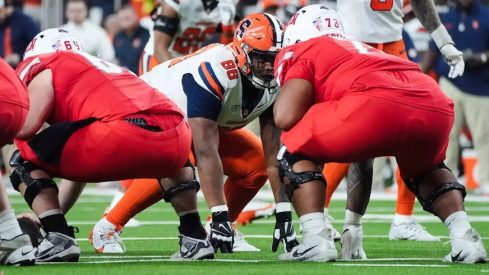With only three starters returning this fall, many not only wondered who would simply see the field, but who would replace stars like Ezekiel Elliott and Michael Thomas as the focal points of the Ohio State offense. Although Mike Weber and Noah Brown have certainly stepped into leading roles through three games, no skill player has been a bigger part of the Buckeyes' early season success than Curtis Samuel.
After backing up Ezekiel Elliott at running back and occasionally moonlighting as a slot receiver during the past two seasons, Urban Meyer and his staff have maximized Samuel's abilities at both positions so far during his third year on campus. But after largely failing to capitalize on the talent brought by Braxton Miller to the same 'H' position last year, the OSU coaches appear to have learned from their mistakes in their efforts to showcase Samuel.
After exploding into the national conversation with 261 total yards and three touchdowns in the season opener against Bowling Green, Samuel followed up with 140 more yards the following week. In his team's most high-profile early-season contest at Oklahoma, the junior from Brooklyn, N.Y. was put squarely in the spotlight and didn't disappoint.
While Samuel would take a handoff on the Buckeyes' first play of the night, his prominence on their next possession would truly encapsulate what kind of threat he poses to a defense. With three receivers lined up to the boundary on the right and only tight end Marcus Baugh on the left, Samuel flares out for a swing pass in that direction, knowing the Sooners will have rolled their coverage the opposite way and leaving him one-on-one in the open field with a 240 lb linebacker.
The big outside linebacker had been forced to stay inside, given the threat Samuel posed as a traditional running back from the backfield. In 107 career carries, he averages 7.2 yards each time he totes the rock, a higher average than Elliott, Miller, or Carlos Hyde produced during their times in Columbus.
But this season, Samuel has also flashed a new set of skills as a downfield receiver. In the opener, he shook a Bowling Green linebacker on a slant route before racing 79 yards for an early score, then followed it up the next week by hauling in an impressive 25-yard catch downfield over two defenders.
As the Buckeyes lined up for second down, the same personnel remained on the field. This time, however, Baugh and Samuel shifted outside before the snap, completely shifting from what appeared to be a run-heavy look to a five-receiver set.
As Samuel shifted to the slot, the entire Sooner secondary rotates their coverage over to account for the new receiver setup on the opposite side of the field. The free safety (#13) had initially been tasked with playing a deep zone, but now would be covering Samuel on any deep ball as the #2 receiver in the defense's 'Quarters' scheme.
With the safety's eyes on Samuel before the ball is snapped, Barrett knows he has a mistmatch between his slot receiver and a safety with no additional help. Though Samuel easily gets behind his defender on the route, the ball is just overthrown, resulting in third down instead of six points.
On that next play, Barrett would try to pick up the first down with his legs, but would fall one yard short while Samuel caught his breath on the sidelines. But he'd be right back for the next play as the Buckeyes looked to convert the ensuing fourth down.
The Sooner secondary was so concerned with defending Samuel as a receiver that they failed to stay true to any responsibilities in the running game. While keeping one of the two defensive backs that stayed with Samuel back on the left side with Baugh may not have prevented a first down, it would've at least forced some of the big Buckeye linemen like left tackle Jamarco Jones from getting blocks so far downfield to spring a 36-yard run in which the ball carrier went untouched.
But while Samuel's talents alone are certainly special, Meyer and his offensive staff, led by Ed Warinner and Tim Beck, have done an excellent job of manipulating defenses with formation and motions to get their new star in the best position to succeed. According to Pro Football Focus, Samuel has logged 73 snaps at receiver, 64 in the backfield, and taken six direct snaps.
Most importantly, though, what he has done after the snap as either a traditional running back or slot receiver have allowed him to thrive, unlike the predictable usage patterns that plagued the experiment with Miller in the same role last season. With fewer known weapons this year, Warinner is almost forced to utilize Samuel as a traditional inside runner, possession man in the slot, or as a downfield receiver; all of which can not only gut defenses on their own, but can force them to overreact one way or another.
The results are speaking for themselves, as Samuel finds himself among some pretty impressive company when looking at the stat sheet:
| Name | School | Games | Rush Yds | Rec Yds | Yards-per-touch | YArds-per-game |
|---|---|---|---|---|---|---|
| Donnel Pumphrey | SDSU | 3 | 599 | 67 | 8.1 | 220.0 |
| Christian McCaffrey | Stanford | 3 | 436 | 119 | 6.1 | 185.0 |
| I'Tavius Mathers | MTSU | 4 | 447 | 260 | 8.2 | 176.8 |
| Amba Etta-Tawo | Syracuse | 4 | 0 | 706 | 17.7 | 176.5 |
| Curtis Samuel | Ohio State | 3 | 260 | 259 | 10.8 | 173.0 |
While this list features three of the best running backs in the nation, as well as the leading receiver, only McCaffrey is putting up better numbers at a program that is currently ranked. When compared to his counterparts within the Big Ten, however, Samuel has easily distanced himself from the pack as the most dangerous weapon on the field at any time, with Rutgers running back Robert Martin in second-place while averaging 46 fewer yards per contest.
Unlike seasons past, defenses will no longer be able to simply stack the box to stop the Buckeyes' most dangerous weapon offensively. Samuel's ability to attract attention no matter where he lines up will influence defensive game plans for the remainder of the season, and it will be interesting to see how Warinner and Beck use that focus to open up opportunities for his teammates.
Perhaps most importantly, though, Samuel has allowed his quarterback to flourish. After a season in which he often was not at his best, Barrett has been given a much greater amount of responsibility this fall, regularly changing plays at the line based on the defense's alignment. That job becomes much easier, of course, when a swiss-army-knife is lining up next to him.
As the season wears on and more familiar opponents that have seen the Buckeyes before begin to show up on the schedule, the coaching staff will have to work to keep their opponents from identifying tendencies in the way they distribute the ball so effectively. But for a team that had so many question marks heading into the season, Curtis Samuel is a big reason why they find themselves ranked second and considered a favorite to make the playoff after only three games.


